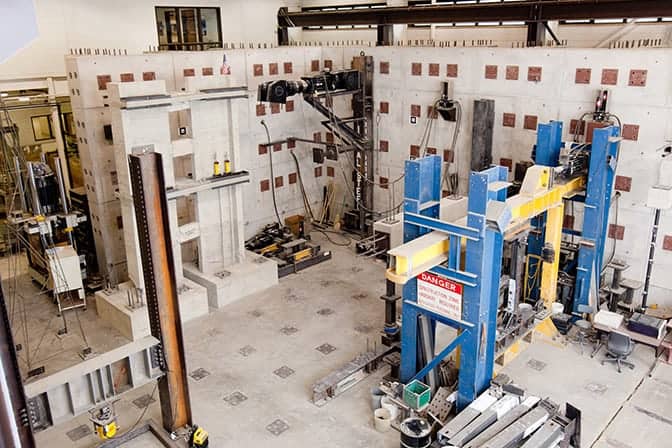Structural Engineering Lab

The Structural Engineering Laboratory at the University of Michigan is well-equipped for structural testing of large-scale structural elements and subassemblies under monotonic and quasi-static cyclic loading. The principal element of our Laboratory is a strong wall and floor system which forms a continuous L-shaped corner. The strong floor is a 5-foot deep, heavily reinforced concrete mat. The walls are 20 feet high and 2 feet thick, backed by 8-foot deep buttresses on 8-foot centers. Both the walls and the buttresses are post-tensioned to the strong floor. The test area is serviced by a 10-ton overhead crane.
The structural floor has tie-down locations (anchorages) positioned at 4-foot centers in two perpendicular directions. Identical anchorages are provided in the two structural walls, with extra anchorages added at the centerline of the buttresses. The wall anchorages at the buttresses and in the strong floor have a capacity of 300 kips in tension and compression and 200 kips in shear. The wall anchorages adjacent to the buttresses have a capacity of 100 kips. The total design load and overturning moment per buttress are 600 kips and 5400 kip-ft, respectively.
A test control room and the hydraulic power supply area, featuring pumps with a capacity up to 120 gpm, are located adjacent to the test floor. The laboratory is equipped with a series of hydraulic actuators of various load (up to 328 kips), stroke (up to 16 inches) and servo-valve capacities for static, dynamic and fatigue testing. Three servo-controlled closed loop testing systems with 30 kip, 125 kip and 550 kip capacities are also available. Experiment control and data acquisition is performed using several modern computer-driven systems. The synergy of the hydraulic power capacity, computerized control of the hydraulic actuators and the data acquisition systems makes it possible to perform pseudo-dynamic simulation tests.
Related Research
Graduate Study